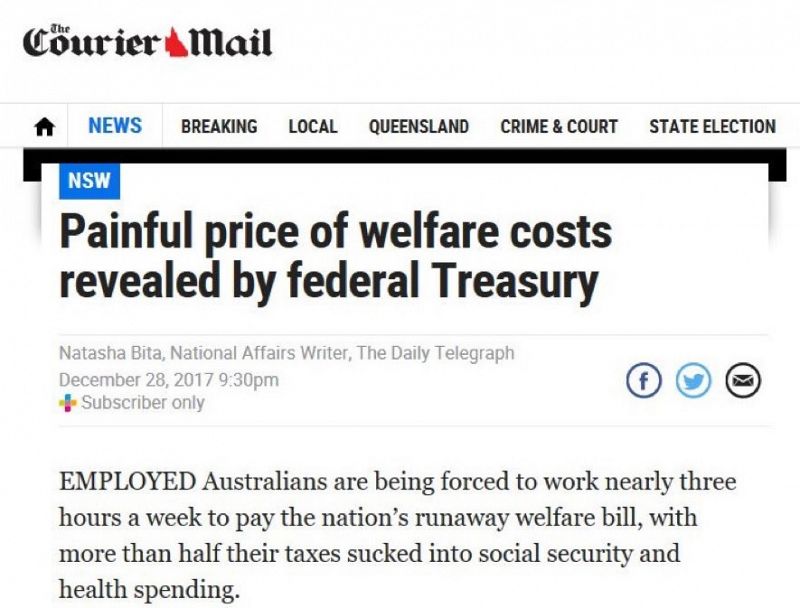If you’re a Government propagandist, the silly season always provides a happy hunting ground.
Newsrooms are thinly staffed, and there’s little beyond the holiday road toll and bushfires to fill the bulletin until the sports report kicks in. This means the bar for "news" is set abnormally low. A perfect time, then, to flick the "Our-Welfare-Bill-is Out-of-Control" switch.
And so it was that in the cicada-punctuated slumber between Christmas and New Year that Murdoch’s Daily Telegraph, the preferred propaganda arm of the Turnbull Government in manufacturing kick-down economics, proclaimed that Australians were being “forced” to work nearly three hours a week to pay the nation’s “runaway” welfare bill. More than half our taxes, the tabloid hyperventilated, were being “sucked into” social security and health spending.
Naturally, the commercial television breakfast news shows (where perfectly coiffed, overpaid himbos and bimbos multiskill by smiling, frowning and reading the autocue all at once) did a ritual rip-and-read straight out of the Telegraph, of course echoing the mildly outraged tone of "our money wasted on good-for-nothing layabouts".
Now, as a former economics journalist, I’m all for the commercial media giving more time to tough macro policy stories and less time to break-and-enters, car crashes out west and two-headed mongooses, but if they’re going to meekly regurgitate this bait-and-switch bullshit, do you think they could perform even a cursory journalistic check first?
WHAT THE FORK?
Working Aussies are forking out three hours of their weekly wage to fund the nation’s welfare bill.
— Sunrise (@sunriseon7) December 28, 2017
⁰The average taxpayer hands over $83 a week to prop up welfare recipients. pic.twitter.com/PeBRO7u1iO
Firstly, define your terms. What does it mean to say we are “forking out three hours” of our weekly wage on “welfare”? Is Australia’s welfare bill disproportionately bigger or growing faster than other those of other industrialised countries? What is included in this definition of welfare? Why is welfare always characterised as automatically wasteful? Why do we not hear about the billions of revenue foregone each year by providing tax breaks to the wealthy?
Australia has a progressive income tax system. That means the average tax rate – the total amount of tax paid as a percentage of income – increases as each taxpayer’s income increases. So taxpayers on up to $18,200 per annum pay no income tax. They are taxed 19 cents for each $1 over $18,200. This increases to 32.5 cents for each $1 over $37,000, to 37 cents for each $1 over $87,000 and, finally, to 45 cents for each $1 over $180,000. (These numbers do not include the Medicare levy of 2%.)
The Terror’s story quotes Treasury as “revealing” that of the average taxable income of $58,000 a year, a total of $11,427 is paid to the taxman. Well, yes, that is the tax scale, including the Medicare levy of 2%. This is not news. The story then goes on to say that this means the average income earner is paying $83 a week for welfare, including $35 a week on aged pensions, $20 a week on family payments, $17 a week on disability payments and $6.30 a week on the unemployed. Another $42 a week is spent on healthcare and $20 a week on defence. Again, so what? What do people think the tax system is for?
The average Australian worker is handing over $83 per week to pay for the nation’s welfare bill. #9News pic.twitter.com/sE0o35u5l3
— Nine News Australia (@9NewsAUS) December 28, 2017
We pay tax to fund essential goods and services — for our defence, for our education system, for healthcare, to support our aged to ensure dignity in retirement, to look after the needs of the disabled and those who for no fault of their own cannot find work. Typically, people always complain about their tax “burden”, but neither is the population ever likely to call for the elimination of services. In this case, the economically responsible thing for governments to do is to ensure they raise sufficient tax revenues to meet the services that a civilised democracy demands. That they don’t is part of the magic pudding debt-and-deficit problem we’ve become depressingly accustomed to.
Again, none of this is newsworthy. The bigger questions are around whether Australia’s tax take is comparably more than those of other countries and whether our social welfare bill is disproportionate in global terms. It would have taken a reporter of even modest ability about five minutes to answer those questions.
SOME FORKING FACTS
Australia’s overall government tax revenues this fiscal year are around 24% of GDP. We do not have current year comparisons for other industrialised nations, but in 2014 Australia was one of only nine countries in the OECD (the world’s club of rich countries) with a revenue to GDP rate of below 30%. The others were Chile, Ireland, Korea, Latvia, Mexico, Switzerland, Turkey and the United States. (These numbers are sourced from the OECD paper ‘Revenue Statistics 2016′).
Neither is our social spending particularly high in global terms. In fact, on most measures, we are significantly below the average. In overall terms, our social spending in 2016 was just over 19% of GDP — below the OECD average of 21%.
In fact, we are even below the United States on this measure, which comprises cash benefits for low-income households, the elderly, disabled, sick and unemployed.
It is true that Australia’s social security and welfare portfolio is the single biggest item in overall government outlays, at 35%. If you add in health expenditure, our total expenditure in this area is just over 50%. But is this unusual in global terms? No. According to the OECD database, the proportion of government spending on social welfare and health in 2013 ranged from as high as 58.2% in Spain, to 29.4% in Korea. Most countries were grouped between 48% and 54%.
The other point here is that within our social welfare budget the single biggest item is the age pension, representing $64 billion this fiscal year, or more than a third of the overall social security and welfare expenses. The second biggest and fastest growing component is spending related to the national disability support scheme. Contrary to tabloid hysteria about dole bludgers, spending on the unemployed and sick is budgeted at just over $10 billion this year, or about 6% of our overall spending on social welfare. (See Table 9 from 2017/18 Budget below).
If you have a real journalist on staff perhaps just get them to Google the budget paers. By far the biggest component of ‘welfare’ is the age pension at about six times the outlay for the unemployed. But here, I did it for you. Stick to reporting the Kardashians in future. pic.twitter.com/nlCWxM3Yoa
— Mr Denmore (@MrDenmore) December 28, 2017
Is our spending on unemployment benefits unusually high? Again, no. The chart below compares overall spending on unemployment benefits in OECD countries as a proportion of GDP. At 0.6%, we’re below the average.
A FORKING CONCLUSION
Australia is not a particularly highly taxed country in income terms. Our social welfare budget is average or below-average depending on the component measure. The call on taxpayers to fund our not particularly generous social safety net is not especially onerous.
And, of course, none of this takes into account the significant tax expenditures (exemptions, deductions, credits etc;) that overwhelmingly go to the already wealthy. According to an earlier leak by Treasury (which funnily enough the ‘we’re-for-the-battlers’ crew at the Telegraph totally ignored) these tax expenditures (including negative gearing, capital gains tax concessions and superannuation ‘incentives’) amount to about $150 billion a year or virtually the same size as the total social welfare budget. And keep in mind that about a third of companies pay no tax at all.
Which all tends to beg the question of whose interests are being served with this silly season beat-up. Perhaps this is coming from a government that is attempting to drum up the case for corporate tax cuts in a race to the bottom with the Trump-led USA? More importantly, what does it say about the Fourth Estate in this country that such a transparent scare story (aimed at creating an Us versus Them climate to sow division) can so easily be planted in the public domain with no journalist remotely challenging it?
Checking this stuff, not meekly re-running the government’s self-serving line and providing context for people are really what journalists are paid to do. The consequences of them not, of just providing manufactured outrage for ratings points, don’t really bear thinking about. This worries me. It should worry you too.
Whilst we're on the topic of welfare...who do you actually think pays the greater proportion of tax in this nation?
— ▌│█║▌║▌║ Rod Moffatt (@Ozlandscapes) December 28, 2017
A hint...it's not companies!
Largest form of welfare in this nation, by a country mile, is corporate welfare!!#auspol pic.twitter.com/8MULk89ZTR
This story was originally published on The Failed Estate on 29 December 2017 under the title 'Us and Them' and has been republished with permission. You can follow Jim Parker on Twitter @MrDenmore.
One of these people, who worked and paid tax in Australia for 40 years, receives a single age pension of $23,000 per year. The other heads a company which earned $2.9b in Australia in 2016 and paid zero tax. Which one’s the welfare bludger? pic.twitter.com/rBnwJnGqKn
— Mr Denmore (@MrDenmore) December 30, 2017
Monthly Donation
Single Donation
Here's the list of Australia's biggest welfare bludgers (and #LNP corporate donors - coincidence, of course) https://t.co/8586SWkWLz #auspol pic.twitter.com/Cevqzgnp3z
— Ming The Merciless (@MGliksmanMDPhD) December 29, 2017
Subscribe to IA. It's pretty forking good!











